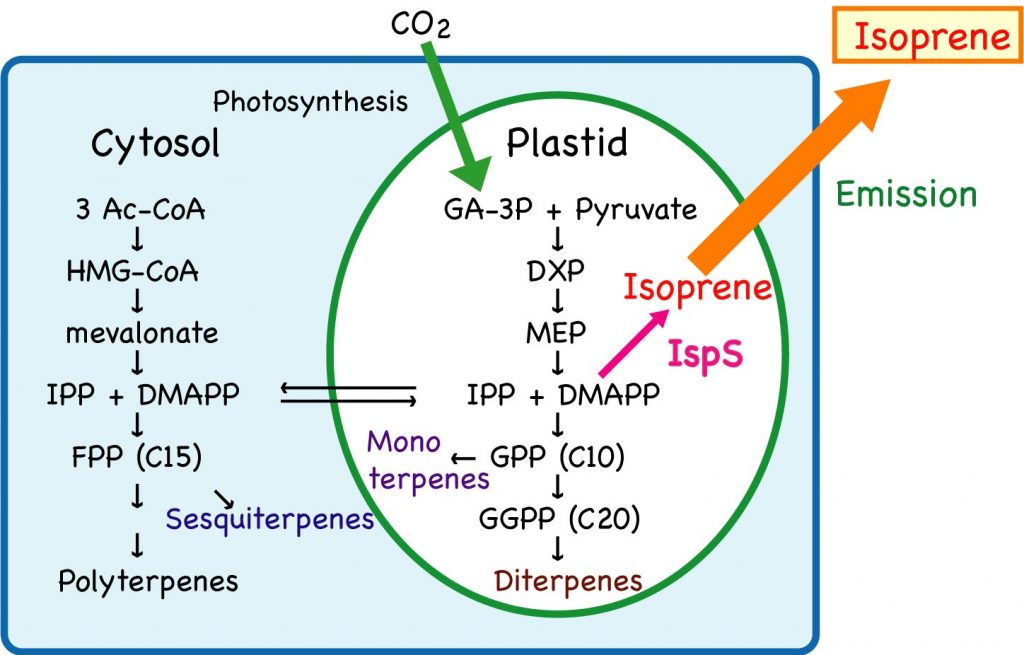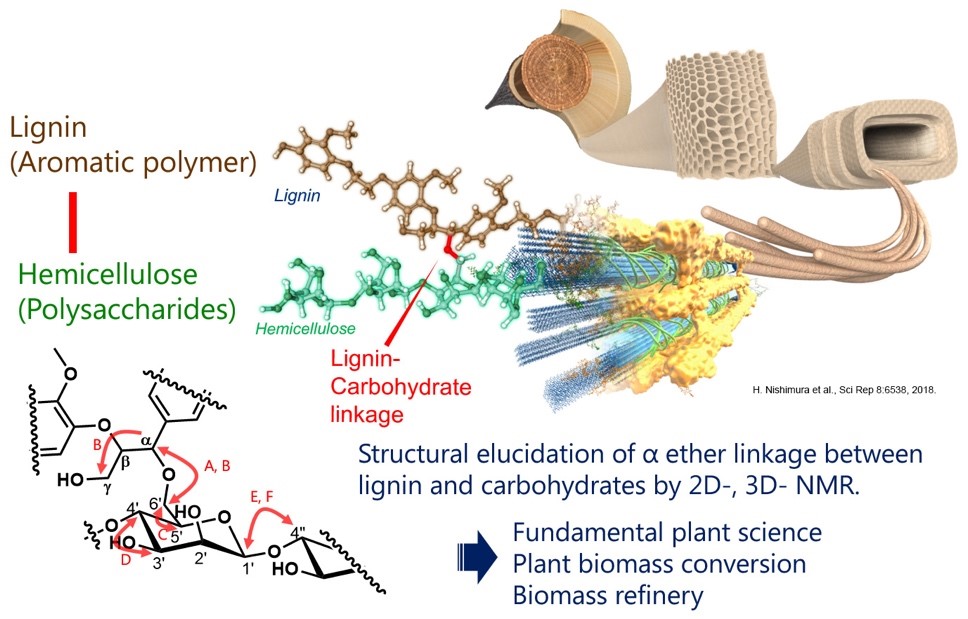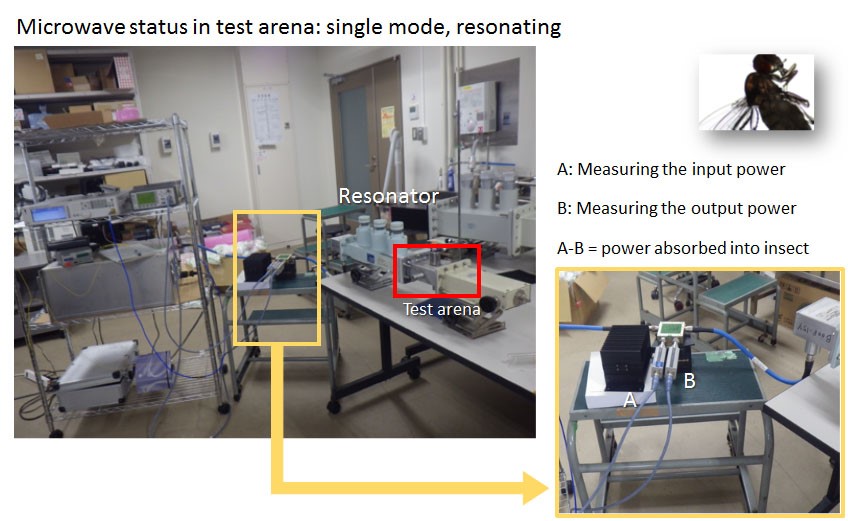2017 Activity Report for Mission 5-2: Establishing a Society with Reduced Dependence on Fossil Resources: Plants, Biomass, Energy, and Materials
Updated: 2018/06/22
<Molecular Breeding of Biomass Plants and Synthetic Biology>
Tailor-made breeding of grass biomass through lignin bioengineering (Toshiaki Umezawa, Yuki Tobimatsu, Shiro Suzuki)
To explore new breeding strategies to improve the production of bioenergy and biomaterials from grass biomass, this project seeks to develop and characterize transgenic rice plants that produce biomass with variously modified lignin contents and structures. We are also working on the selection and breeding of grass biomass crop varieties with superior lignin characteristics.
Research Activities
- Transcription factor-mediated upregulation of rice lignin biosynthesis for the production of energy-rich biomass.
- Development of transgenic rice plants with variously altered lignin composition and substructures.
- Variety selection of grass biomass crops, e.g., sorghum, Erianthus, and sugarcane
Publications, etc.
- Koshiba et al., MYB-mediated upregulation of lignin biosynthesis in Oryza sativa towards biomass refinery. Plant Biotechnol. 34:7-15 (2017).
- Lam et al., Disrupting Flavone Synthase II alters lignin and improves biomass digestibility. Plant Physiol. 174:972-985 (2017).
- Takeda et al., Regulation of CONIFERALDEHYDE 5-HYDROXYLASE expression to modulate cell wall lignin structure in rice. Planta 246:337-349 (2017).
- Cui et al. Host lignin composition affects haustorium induction in the parasitic plants Phtheirospermum japonicum and Striga hermonthica. New Phytol., 210:710-723 (2018).
- Miyamoto et al., Comparative analysis of lignin chemical structures of sugarcane bagasse pretreated by alkaline, hydrothermal, and dilute sulfuric acid methods. Ind. Crops Prod.121:124-131 (2018).
- Miyamoto et al., A comparative study of the biomass properties of Erianthus and sugarcane: lignocellulose structure, alkaline delignification rate, and enzymatic saccharification efficiency. Biotechnol. Biochem. in press (DOI: 10.1080/09168451. 2018.1447358).
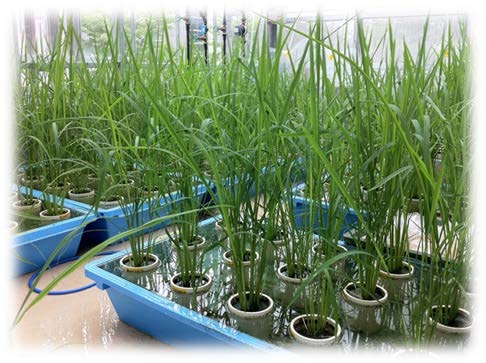 |
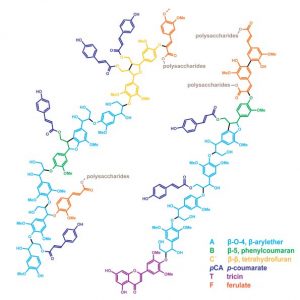 |
Figure: Lignin-modified transgenic rice plants grown in a greenhouse (left) and structural models of lignins in grass biomass or cell walls (right).
Development of isoprene production utilizing solar energy with photosynthetic microorganisms (Kazufumi Yazaki, Akifumi Sugiyama)
Isoprene is used worldwide as an industrial compound in materials such as synthetic rubber. Currently, the isoprene supply depends fully on fossil fuels, which will be depleted in the future. Thus, the development of a sustainable isoprene production method is required. In this study, we aim to establish methods to produce isoprene from sustainable resources, such as diatom (Chaetoceros gracilis), a photosynthetic microorganism, by metabolic engineering using an isoprene synthase gene from Populus alba.
Research Activities
- A transgenic diatom (Chaetoceros gracilis) expressing IspS of Populus alba was generated.
- Isoprene production was achieved in the transgenic diatom.
Publications, etc.
We filed patent applications.
Figure: Emitter plants release isoprene derived from MEP pathway.
<Innovative Biomass Conversion Technologies>
Conversion of biomass into chemical resources using a microwave and biological process (Takashi Watanabe, Hiroshi Nishimura)
Research Activities
Lignin monomers for epoxy resin were produced with high selectivity by industry−university joint research. We succeeded in controlling the thermodynamic properties of the lignin-based epoxy resin by designing a chemical modification of the monomer unit. We analyzed detailed structures of the lignin oligomers produced, and reported these results in original papers.
Lignin monomers for functional polymers were produced in a yield more than twice that of conventional heating. A continuous 915 MHz microwave reactor was developed by industry−university joint research and applied to the degradation of woody biomass. The mechanisms underlying the acceleration effects were analyzed using model compounds.
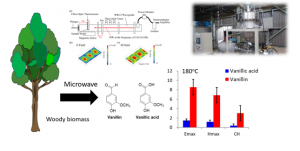 |
 |
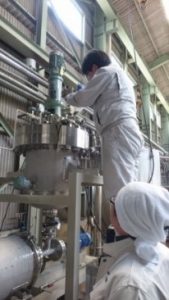 |
Figure: Continuous 915 MHz microwave reactor developed by CREST project and experiments of wood degradation by a copper oxide reaction which produces vanillin in 2-3 times higher yields than those of conventional heating. Experiments using a cavity resonator revealed that electric field significantly accelerated the reaction. A thermostable polymer was synthesized from vanillin produced by the microwave reaction of Japanese cedar wood.
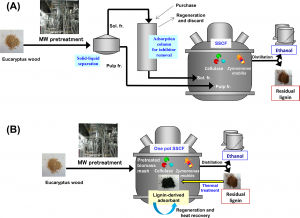 |
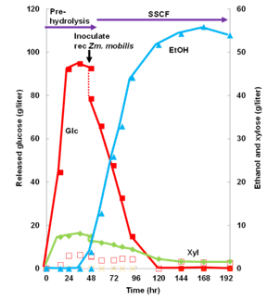 |
Figure:Self-sufficient bioethanol production system was developed using a residual lignin-derived adsorbent for fermentation inhibitors. The adsorbent was prepared by thermal treatment of the lignin released in a process of bioethanol production.
Publications, etc.
- Kaiho, D. Mazzarella, M. Satake, M. Kogo, M., R. Sakai, Takashi Watanabe, Construction of di(trimethylolpropane) cross linkage and phenylnaphthalene structure coupled with selective β-O-4 bond cleavage for synthesizing lignin-based epoxy resins with controlled glass transition temperature. Green Chem., 18, 6526-6535 (2016).
- Saito et al., Characterization of the interunit bonds of lignin oligomers released by acid-catalyzed selective solvolysis of Cryptomeria japonica and Eucalyptus globulus woods via thioacidolysis and 2D-NMR, Food Chem., 64:9152–9160 (2016).
- Yoshioka et al., Self-sufficient bioethanol production system using a lignin-derived adsorbent of fermentation inhibitors, ACS Sus. Chem. Eng. 6:3070–3078 (2018).
- Qu et al., Direct production of vanillin from wood particles by copper oxide–peroxide reaction promoted by electric and magnetic fields of microwaves. ACS Sus. Chem. Eng. 5:11551–11557 (2017).
- Nishiwaki-Akine et al., Transparent woody film made by dissolution of finely divided Japanese beech in formic acid at room temperature, ACS Sus. Chem. Eng. 5:11551–11557 (2017).
Design of green biomass conversion based on an analysis of branched structures on lignocellulose (Hiroshi Nishimura, Takashi Watanabe)
To design a separation and a conversion of lignocellulose, knowledge of molecular structures in a branched lignin and lignin−carbohydrate complex is important. Here, we explore new enzymatic conversion processes based on the fundamental analysis for lignocellulose molecules.
Research Activities
- Development of a 2D-NMR method for the accurate quantification of lignocellulose.
- Fractionation of lignin-carbohydrate complex from wood biomass.
- Enzymatic reactions for the cleavage of lignin-carbohydrate linkages.
Publications, etc.
- Okamura, H., Nishimura, H., Nagata, T., Kigawa, T., Watanabe, T., Katahira, M., Accurate and molecular-size-tolerant NMR quantitation of diverse components in solution. Sci.Rep. 6, 21742 (2016).
- Nishimura, H., Kamiya, A., Nagata, T., Katahira, M., Watanabe, T. Direct evidence for alpha ether linkage between lignin and carbohydrates in wood cell walls. Sci.Rep. 8:6538 (2018).
- Nikkei (newspaper) (2018.5.7)
- Hiroshi Nishimura, Structural analysis towards the lignocellulosic biomass conversion, The 1st International Symposium on Fuels and Energy, Hiroshima (2017.7) (Invited lecture)
- Hiroshi Nishimura, Structural analyses and the bioprocesses for wood biomass conversion, Asia Research Node Symposium on Humanosphere Science, Penang, Malaysia (2017.2) (Invited lecture)
In situ observation of the structural change of biomass for the aim to develop an efficient enzymatic saccharification process (Tomoya Imai, Junji Sugiyama)
The first step of cellulosic biomass conversion to useful small chemicals is saccharification. Especially enzymatic saccharification is very important process given its low environmental impact and low energy consumption. However conversion rate from biomass to sugar by enzymatic saccharification is often far less than 100%, and then improvement of this process has been a big issue for industrial realization of biorefinery. Given this background, a basic study was conducted for analyzing the biomass solid structure during its enzymatic digestion by using small angle X-ray scattering (SAXS). In situ SAXS measurement of biomass saccharification by cellulase demonstrated no apparent change of submicron structure of biomass during the digestion in neither case of lower nor higher saccharification. The result will provide many hints for more efficient enzymatic saccharification process.
Research Activity
Paavo A. Penttilä, Tomoya Imai, Jarl Hemming, Stefan Willför, Junji Sugiyama, Enzymatic hydrolysis of biomimetic bacterial cellulose–hemicellulose composites. Carbohydrate Polymers 190:95-102 (2018).
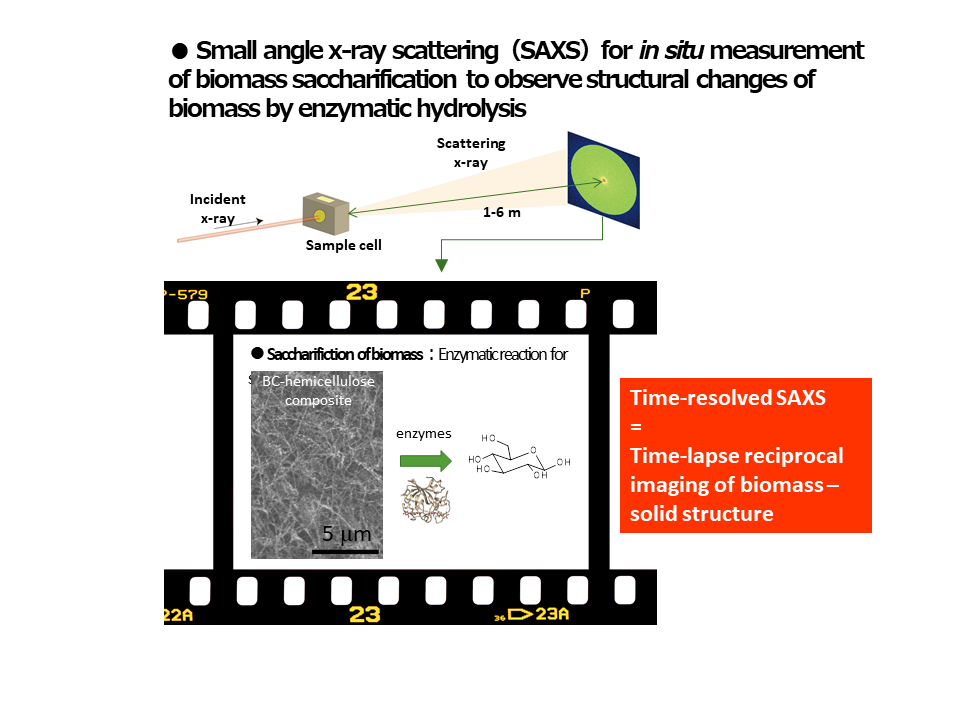 Figure: Small angle X-ray scattering (SAAXS) for in situ measurement of biomass saccharification to observe structural changes of biomass by enzymatic hydrolysis
Figure: Small angle X-ray scattering (SAAXS) for in situ measurement of biomass saccharification to observe structural changes of biomass by enzymatic hydrolysis
<Advanced Functional Materials from Biomass>
Development of high-strength products based on cellulose and chitin nanofibers (Hiroyuki Yano, Kentaro Abe)
Recently, natural nanofibers such as those of cellulose and chitin, which are major components of plant cells and the shells of crabs and shrimp, respectively, have received great interest by virtue of their outstanding mechanical properties. The aim of this study is to develop high-strength products (film, spun fiber, filters, etc.) based on cellulose and chitin nanofibers. Specifically, cellulose nanofibers are converted into stable hydrogels by NaOH treatments. Based on this behavior, we here report the preparation of wet spinning of fibers made of cellulose nanofibers. Because this method does not dissolve cellulose at all, the resultant fibers showed the higher cellulose crystallinity as compared to conventional regenerated cellulose.
Research Activities
- Simple nanofibrillation of high-concentration pulps
- Wet-spinning of cellulose nanofiber
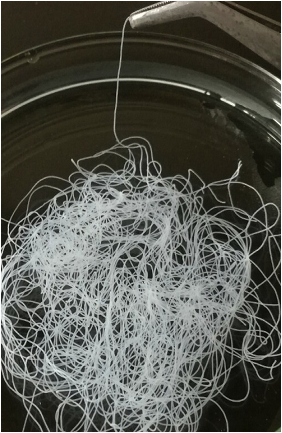
Figure : Wet-spun fiber based on cellulose nanofiber.
Development of energy storage device from biomass (Toshimitsu Hata)
The primary factors of electric double-layer capacitors from biomass with high purity and high carbonization yield are high energy density and high charge and discharge performance. In this research, composite carbon materials from biomass derived material and thermosetting phenolic resin are prepared to develop a high-performance super capacitor.
Research Activity
Freeze drying treatment improve the microstructure and nanopores of carbon composite, leading to high electrostatic capacity of electric double layer capacitor.
Conferences, etc.
- Onishi, I.Ide, T.Hata, Microstructure of carbon composites from phenolic resin and cellulose nanofiber, The 15th wood carbonization research society, Fukuoka, 6. 2017
- Onishi, T.Hata, I.Ide, T. Saito, S. Suzuki, Subyakto, Yusup Amin, Electrochemical property of carbonizaed thermosetting phenol resin with cellulose nanofiber, 44th annual meeting of the carbon society of Japan, Kiryu 12. 2017
- Onishi, I.Ide, T.Hata, Subyakto, Yusup Amin, T. Saito, S. Suzuki, Effect of freeze drying process on charge and discharge characteristics of composite carbon material of phenolic resin and cellulose nanofiber, 68th the Japan wood research society, Kyoto, 3.2018
<Implementation of Microwave-based Wireless Power Transmission Technologies>
Development of IoT technology with wireless power transfer via microwaves (Naoki Shinohara, Tomohiko Mitani)
Toward a post-fossil-fuel society, IoT (Internet Of Things) technology for a sophisticated society is required. In this project, we are developing an unconscious wireless charging system and battery-less sensor with wireless power transfer via microwaves. We propose new IoT technology with wireless communication and wireless power and carry out field experiments.
Research Activities
- Development of battery-less sensor with wireless power transfer via microwaves for nursing homes as a JST research project named ‘Center of Innovation’ at Kyoto University.
- Development of a battery-less sensor with wireless power from a flying multi-copter to measure the parameters of volcanos, and field experiments of the developed systemon Izu island and in Fukushima prefecture.
Publications, etc.
- Wang et al., Study on 5.8 Ghz single-stage charge pump rectifier for internal wireless system of satellite, IEEE-Trans. MTT, 65:1058-1065 (2017).
- Matsumuro et al., Study of a single-frequency retro-directive system with a beam pilot signal using dual-mode dielectric resonator antenna elements, Wireless Power Transfer, 4:132-145 (2017).
- Matsumuro et al., Novel dielectric elements for high-directivity radiation, IEICE Trans. Electron, E100-C:607-617 (2017).
- Yang et al., Experimental study on a 5.8 GHz power-variable phase-controlled magnetron, IEICE Trans. Electron, E100-C:901-907 (2017).
- Christos Kalialakis, Nuno Borges Carvalho, Naoki Shinohara, and Apostolos Georgiadis, Selected developments in wireless power transfer standards and regulations, IEEE Standards University E-Magazine, , 2016.3.
- http://www.standardsuniversity.org/e-magazine/june-2016/selected-developments-wireless-power-transfer-standards-regulations/
- (Invited) Naoki Shinohara, Antennas for Wireless Power Transmission, 10th European Conference on Antenna and Propagation (EuCAP2016), Davos, 2016.4.10-15, CD-ROM 1570245673.pdf.
- (Keynote) Naoki Shinohara, Current Research and Development Activities of Wireless Power Transfer via Radio Waves, IEEE Wireless Power Transfer Conference(WPTc2016), Aveiro, 2016.5.5-6.
- Naoki Shinohara, Simultaneous WPT and Wireless Communication with TDD Algorithm at Same Frequency Band (Chapter 9), Wireless Power Transfer Algorithms, Technologies and Applications in Ad Hoc Communication Networks, eds. Sotiris Nikoletseas, Yuanyuan Yang, and Apostolos Georgiadis, Springer, ISBN 978-3-319-46810-5, 2016.7, pp.211-230.
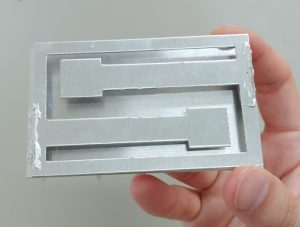 |
 |
Figure : Developed Thin Antenna near Human Body for Microwave Power Transfer in 2017
Estimation of microwave impacts on insect ecology from human activity (Aya Yanagawa, Tomohiko Mitani)
The demand for microwave technology will continue to increase. For the safety and development of the IoT (Internet of Things), it is essential to learn its impacts on nature. We would like to establish a method for estimating such impact by using insect ecology as a model system.
Research Activities
- ESR analysis of sample insects.
- Measuring the electric permittivity of architectural/building materials.
- Check the microwave power-dependent microbial susceptibility change on termites.
- Promoting the partnership with high school as an University-High school initiative project
- Start the collaboration with the research team, LBE INRA Narbonne (France)
Conferences, etc.
- Yanagawa, A., Insects and human activities on microwave usage, HSS2017/7th ISSH, Bogor, Indonesia (November, 2017) (invited)
- Yanagawa A, et al, Heat energy absorbance in insect body under electromagnetic field of the IoT (Internet of Things), 62th annual meeting of Japanese society of Applied Entomology and Zoology, Kagoshima, Japan (March, 2018)
Figure : Measuring the microwave power absorbed into insect body


